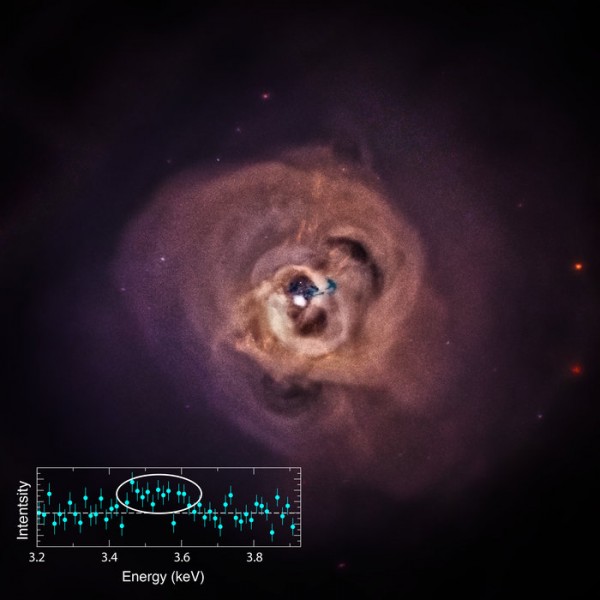Scientists Reveal First Hard Evidence of Dark Matter
| Ana Verayo | | Dec 12, 2014 09:09 AM EST |
(Photo : NASA/CXC/SAO/E.Bulbul, et al.) This unidentified X-ray emission line from the Perseus galaxy cluster requires further investigation to confirm both the signal’s existence and nature.
Physicists claim they've found hard evidence to prove the existence of dark matter, the material that holds the universe together.
Decades ago, astronomers acknowledged the presence of dark matter, saying it accounts for almost a fourth of the total matter in the universe. Dark matter keeps matter together.
Like Us on Facebook
In contrast, the stars, planets, galaxies and all other physical objects comprise only about four percent of the total matter in the universe.
The dark matter theory was developed by scientists in an attempt to further understand how galaxies rotate and move. Dark matter doesn't emit light or any type of electromagnetic radiation, making it a challenge to detect its existence.
Astrophysicists from the Ecole Polytechnique Federale de Lausanne (EPFL) and the Laboratory of Particle Physics and Cosmology (LPPC) have analyzed X-rays originating from the Andromeda and Perseus cluster galaxies.
Using the orbiting XMM-Newton telescope managed by the European Space Agency, the researchers removed all signals from known particles of the X-rays. One signal, however, remained unknown and this signal interacted with ordinary matter.
This unknown signal isolated from the X-rays corresponds exactly with the galaxies' motions, which are concentrations of intense signals located in the core of the objects that fade out or diffuse from the edges, according to Oleg Ruchayskiy from the EPFL.
This signal is manifested through a rare process where a photon and the destruction of a sterile neutrino interact with each other via gravity. Scientists consider them so elusive that they're dubbed the "ghost of a ghost".
If this theory is proven correct, it will mean the universe actually holds four times as much dark matter as opposed to ordinary, visible matter.
This discovery may lead to developing new telescope technology able to study and examine further the signals emitted by dark matter particles, according to Alexey Boyarsky of Leiden University. Doing so will allow scientists to reconstruct how the universe was formed.
This study will be published in the next issue of the journal, Physical Review Letters.
TagsScientists Reveal First Hard Evidence of Dark Matter, dark matter, ESA, XMM-Newton telescope, andromeda galaxy, perseus galaxy cluster, what is dark matter, evidence dark matter X-rays galaxies
©2015 Chinatopix All rights reserved. Do not reproduce without permission
EDITOR'S PICKS
-

Did the Trump administration just announce plans for a trade war with ‘hostile’ China and Russia?
-

US Senate passes Taiwan travel bill slammed by China
-

As Yan Sihong’s family grieves, here are other Chinese students who went missing abroad. Some have never been found
-

Beijing blasts Western critics who ‘smear China’ with the term sharp power
-

China Envoy Seeks to Defuse Tensions With U.S. as a Trade War Brews
-

Singapore's Deputy PM Provides Bitcoin Vote of Confidence Amid China's Blanket Bans
-

China warns investors over risks in overseas virtual currency trading
-

Chinese government most trustworthy: survey
-

Kashima Antlers On Course For Back-To-Back Titles
MOST POPULAR
LATEST NEWS
Zhou Yongkang: China's Former Security Chief Sentenced to Life in Prison

China's former Chief of the Ministry of Public Security, Zhou Yongkang, has been given a life sentence after he was found guilty of abusing his office, bribery and deliberately ... Full Article
TRENDING STORY

China Pork Prices Expected to Stabilize As The Supplies Recover

Elephone P9000 Smartphone is now on Sale on Amazon India

There's a Big Chance Cliffhangers Won't Still Be Resolved When Grey's Anatomy Season 13 Returns

Supreme Court Ruled on Samsung vs Apple Dispute for Patent Infringement

Microsoft Surface Pro 5 Rumors and Release Date: What is the Latest?










